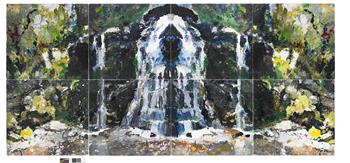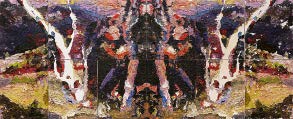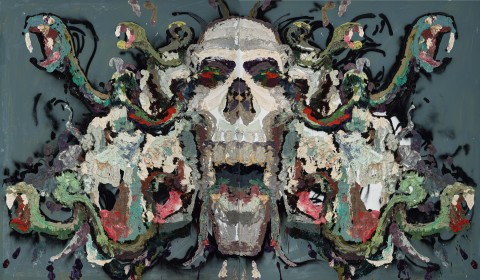RORSCHACH - THE BUTTERFLY EFFECT NO. 2, 2008
BEN QUILTY
synthetic polymer paint, aerosol and oil on linen
214.0 x 366.0 cm overall (diptych)
each signed on tape on stretcher bar verso: QUILTY
GRANTPIRRIE, Sydney
Private collection, Sydney
Smashed, GRANTPIRRIE at the Melbourne Art Fair, Melbourne, 31 July – 3 August 2008, then touring to Newcastle University Art Gallery, Newcastle, New South Wales
BEN QUILTY LIVE, The University of Queensland Art Museum, Brisbane, 8 May – 19 July 2009;
TarraWarra Museum of Art, Victoria, 15 August – 15 November 2009
Slade, L., Ben Quilty, University of Queensland Art Museum, Brisbane, 2009, pp. 116 – 117 (illus.), 135
Slade, L. (et al.), Ben Quilty, Penguin Random House, Melbourne, 2019, pp. 92 – 93 (illus.), 344
In the early 2000s, Ben Quilty smashed his way onto the scene with his exuberant, thick impasto paintings of quintessentially blokey subjects – cars (most often the Torana), hamburgers, and close-up images of the heads of wasted mates after a big night on the turps. Characteristically Australian motifs such as the Budgerigar (which served as a form of portraiture) and iconic historical figures like Captain Cook (at least the school history book version), were also part of his arsenal at this time. Quilty quickly became one of this country’s most recognisable contemporary artists, astutely using his position and profile, and most importantly, his work, to discuss some of the darker aspects of Australian culture and the ongoing legacy of our colonial past.
quilty high res for cat.jpg

Quilty’s paintings have an energy that expects, indeed demands, that the viewer participate in the world he creates – one where figuration hovers at the edge of abstraction, and where the handling of paint is at once immediate, rough and joyful. In his body of Rorschach paintings however, the artist deliberately destroys these luscious surfaces, painting in his characteristically thickly trowelled style before pressing a second unpainted canvas directly onto the first. While Quilty’s paintings are spontaneous and made quickly, these doubled images rely on chance, their new forms only revealed when the two canvases are pulled apart. Like the Rorschach ink blots whose patterns were used in early psychological testing, the effect of pareidolia – the experience of seeing images in visual patterns, is also at play here, and in Quilty’s mirrored images, we are encouraged to ‘see’ our own perceptions and experiences in these ‘accidental’ abstractions.
The titles of Quilty’s Rorschach works are often signposts sent to guide the viewer through the canvases’ colourful squelches of paint, and several of these, such as Fairy Bower Rorschach, 2012 or the monumental Irin Irinji, 2018, refer to specific events of frontier violence in Australia’s colonial history.1 Painted after his first visit in 2016 to the community of Amata in the APY Lands of north-west South Australia, the twelve-panelled Irin Irinji depicts the site of the spearing of a white dingo scalper who defiled a significant water source, and whose death led to the massacre of a group of Aboriginal men. As curator Lisa Slade has noted, Irin Irinji powerfully evokes the burden of intergenerational dispossession and trauma and ‘… summons the contradiction of creation and destruction, the same aporia that is our lived experience of this country’.2
5 DH2022 ART Cat (May 2022) FA3.jpg

Quilty began the painting Rorschach – The Butterfly Effect No. 2 with an image of a skull—a symbol that recurs throughout his practice—its dome-like crown adorned by a cast of serpents. Brandished by many a rebellious youth for its countercultural associations, the gaping mouth of Quilty’s skull calls to mind the imagery of heavy metal, bikers and tattoos, along with the more highbrow associations of the vanitas tradition, and the passing of time, and ultimately, life. Regardless of the way in which you come to it, it seems to both smile at and mock the viewer at the same time. The title of Quilty’s painting refers to the ‘Butterfly Effect’ in Chaos Theory – a concept developed by American mathematician and meteorologist Edward Norton Lorenz as a metaphor to explain the way in which small changes in conditions may have large effects on weather. For Quilty, the Butterfly Effect captures the chaos at the heart of the making of his Rorschach paintings, while also asking, on a more existential level, about the role of art and the artist in contemporary life, and about just how we can make a difference. Given the fact that the artist’s high public profile has been generated as much by his activism and campaigning for various causes as for his art in recent years, he has ably demonstrated that this question is not just a rhetorical concern. For him, in fact, the two, are integrally linked. As he has said:
‘Change is the most powerful, poignant part of my creative process, and then by default, everything that comes out of that is about change. Change is seen in conservative circles as a very dangerous thing, but in my mind, if something’s broken and not right, it needs to change, and there are plenty of parts of my community that are broken, and not right. … [Art and design] carefully, and hopefully compassionately, and constructively … suggest ways to better ourselves. While humanity is a bit broken, there’s always a place for great art to be that vehicle of change, to touch on taboos, and to bring about change …’3
1. See Slade, Dr L, ‘The Colour of Quilty’ in Flanagan, R., L. Slade, V. Namatjira, F. Young and J. Paton, Ben Quilty, Penguin Random House, Melbourne, 2019, p. 34
2. Slade, ibid., p. 33. As the artist said of this work on 12 January 2016 on Instagram: ‘This work is a pale replacement for the non-existent signage across this country commemorating the violent histories of Australia that us Irish Australians prefer to ignore.’ @benquilty (viewed 28 March 2022)
3. ‘Art and Change with Ben Quilty’, National Gallery of Victoria, https://www.youtube.com/watch?v=BPhTIFwiG5Y (viewed 28 March 2022)
KELLY GELLATLY
